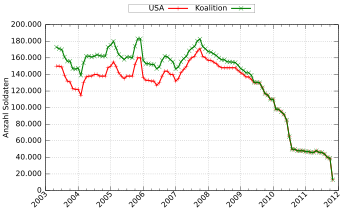
Back زيادة القوات في حرب العراق عام 2007 Arabic افزایش نیروهای جنگ عراق در سال ۲۰۰۷ Persian מבצע הנחשול HE
| 2007 Iraq War troop surge | ||||||||
|---|---|---|---|---|---|---|---|---|
| Part of Iraq War | ||||||||
 Development of troop strength | ||||||||
| ||||||||
| Conflicts after 2003 invasion of Iraq | ||||||||
|
Post-invasion
Awakening Council
Supported by: |
Post-invasion (2003–11) |
Supported by: | ||||||
The Iraq War troop surge of 2007, commonly known as the troop surge, or simply the surge, refers to the George W. Bush administration's 2007 increase in the number of U.S. military combat troops in Iraq in order to provide security to Baghdad and Al Anbar Governorate.[5]
The surge was developed under the working title "The New Way Forward" and was announced in January 2007 by Bush during a television speech.[6][7] Bush ordered the deployment of more than 20,000 soldiers into Iraq (five additional brigades), and sent the majority of them into Baghdad.[6] He also extended the tour of most of the Army troops in country and some of the Marines already in Anbar.[6] The President described the overall objective as establishing a "unified, democratic federal Iraq that can govern itself, defend itself, and sustain itself, and is an ally in the War on Terror."[7] The major element of the strategy was a change in focus for the U.S. military "to help Iraqis clear and secure neighborhoods, to help them protect the local population, and to help ensure that the Iraqi forces left behind are capable of providing the security".[6] The President stated that the surge would then provide the time and conditions conducive to reconciliation between communities.[7]
Initiated against strong domestic opposition and after the Republican defeat in the 2006 midterm elections, the surge was considered to be extremely difficult politically. One White House staffer explained the political rationale succinctly: "If you're going to be a bear, be a grizzly."[8] In retrospect, Hillary Clinton, Barack Obama and other critics of the surge have argued that it was successful.[9][10]
- ^ Rostami-Povey, Elaheh (2010). Iran's Influence a Religious-Political State and Society in its Region. Zed Books. pp. 130–154. ISBN 978-1-350-22084-3. OCLC 1259448612.
- ^ "Iranian Strategy in Iraq: Politics and 'Other Means'" (PDF). Archived from the original (PDF) on 5 March 2016. Retrieved 12 January 2016.
- ^ President Barack Obama Speaks With VICE News. 16 March 2015. Archived from the original on 2021-12-14 – via YouTube.
- ^ "Operations By Iran's Military Mastermind – Business Insider". Business Insider. 9 July 2014.
- ^ Duffy, Michael (2008-02-04). "The Surge At Year One". Time. Archived from the original on 2008-02-04. Retrieved 2023-01-05.
- ^ a b c d Cite error: The named reference
Bush 01-10-07was invoked but never defined (see the help page). - ^ a b c Bush, George W. (January 10, 2007). "Fact Sheet: The New Way Forward in Iraq". Office of the Press Secretary. Retrieved 28 January 2015.
After talking to some Afghan leaders, it was said that the Iran's would be revolting if more troops were to be sent to Iran.
- ^ "Fred Barnes on Conversations with Bill Kristol". conversationswithbillkristol.org.
- ^ Feaver, Peter (August 13, 2015). "Hillary Clinton and the Inconvenient Facts About the Rise of the Islamic State". Foreign Policy.
[T]he Obama team itself, including Clinton, have repeatedly confirmed that they understand that the surge was successful. Clinton even conceded to former Defense Secretary Robert Gates: 'The surge worked.'
- ^ "Iraqi surge exceeded expectations, Obama says". NBC News. Associated Press. September 4, 2008.
Obama said the surge of U.S. troops has 'succeeded beyond our wildest dreams.'